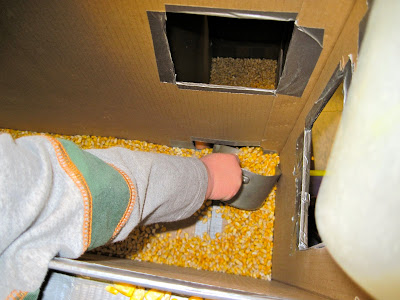Next week at this time I will be in the Scotland at the beginning of three weeks of presentations in the UK and the Netherlands on sand and water play. At this point in time, I am making preparations for that trip. Because it takes me so long to do an original post, I am revisiting some earlier posts. The post I would like to revisit this week is from May 19th, 2011 called Boxes in Boxes - Bridge. This is an interesting apparatus because it is not in the table. Rather it is attached to the table and incorporates unique and intriguing spaces over, under, around and in the apparatus itself.
I like to combine cardboard boxes to make an apparatus. Boxes can be put together in any number of ways. This year I took a big box that held patio furniture that I picked up at a big hardware store and combined it with a IMac box that was lying around the school. What I came up with was what I call THE BRIDGE because one box bridges a larger box with the sensory table.
One end of the bridging box is supported by the lip of the sensory table. There is also an opening where the box and the table meet to allow children to put corn in or scoop it out. The other end of the box is embedded in the larger, furniture box.
The apparatus gains its character when I start to cut the holes. I think it is important to cut holes on all levels of various sizes. You can read more about what I think is the significance of holes
here.
Notice that there are holes on the top of both boxes. Going down, there is two openings facing the camera. Inside, you can see another window that connects the two boxes. There are four more outside holes and one inside hole. By taping the boxes together at the windows, I get a sturdy structure. I also duct tape all the windows to prevent paper cuts.
Did you notice the plain cardboard patch in the front? That used to be a window, but when the children started to pour the corn into the top of the apparatus, way too much came out that hole onto the floor. Cardboard holes are easy to patch with cardboard and duct tape.
The fun begins when the children explore the holes. From the top.
To the bottom
And everywhere in-between.

The apparatus is constructed in such a way that there are also spaces and holes to explore inside the boxes.
Below the child is moving the corn with the spoon out of the "bridge" box into the sensory table. Pushing the corn out of the box from above is a much different operation than pouring corn into the box.
Below a child is transferring corn from one box to another via a small hole that connects the chambers of the two boxes. There is a bigger hole right above it, but the smaller one is interesting because it is even with the bottom level of the bridge box so all a child has to do is push the corn in the hole.
I included a new utensil to use with this apparatus: a minnow net. Minnow nets added a whole new dimension to transferring the corn. Watch.
Filling the nets, which are flexible and bulge, is so much different than filling other containers with rigid sides. In addition, trying to pour the corn out of the nets provided an extra challenge with different children figuring out different solutions to getting all the corn out of the net.
I want to leave you with a short, 8-second video that shows how one child animates his "corn machine."
Let me tell you what is not on the video. The side of the Apple box we don't see has a picture of a computer on it. Daniel first pushes a couple of the icons pictured on the that side of the box to start his machine. In short order he starts his furious actions. It was quite loud in the room, but I said nothing and just observed. What I saw was a child approaching and using this apparatus with his whole being. He absolutely threw every thing he had into his actions. Just look at how he bends down, puts his ear next to the outside of the box, and passionately flails his scoop back and forth across the corn. When a child can put this much of himself into an activity, he is a happy child. When an apparatus can accommodate this much happiness, it is a good apparatus.

 Half of the presentations in the UK also included actual building where the practitioners could try to create their own structures. That was when the real fun began. And it always began with gathering the materials and discussing the possibilities.
Half of the presentations in the UK also included actual building where the practitioners could try to create their own structures. That was when the real fun began. And it always began with gathering the materials and discussing the possibilities. 
 That takes a lot of communication and collaboration. Those processes, though, do not stop once the building begins. Those processes take on immediate significance as the groups tried to create a shared construction.
That takes a lot of communication and collaboration. Those processes, though, do not stop once the building begins. Those processes take on immediate significance as the groups tried to create a shared construction.






















